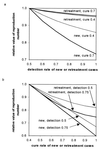Criteria for the control of drug-resistant tuberculosis
- PMID: 10859359
- PMCID: PMC16690
- DOI: 10.1073/pnas.140102797
Criteria for the control of drug-resistant tuberculosis
Abstract
Antibiotic resistance is a growing impediment to the control of infectious diseases worldwide, tuberculosis (TB) being among them. TB kills two million people each year and foci of multidrug-resistant TB (MDR-TB) have been identified in Eastern Europe, Africa, Asia, and Latin America. A critical question for health policy is whether standardized short-course chemotherapy for TB, based on cheap first-line drugs, can prevent and reverse the spread of drug resistance. Here we use mathematical modeling, in conjunction with treatment results from six countries, to show that best-practice short-course chemotherapy is highly likely to bring strains resistant to either of the two key drugs isoniazid and rifampicin under control and to prevent the emergence of MDR-TB. However, it is not certain to contain MDR-TB once it has emerged, partly because cure rates are too low. We estimate that approximately 70% of prevalent, infectious MDR-TB cases should be detected and treated each year, and at least 80% of these cases should be cured, in order to prevent outbreaks of MDR-TB. Poor control programs should aim to increase case detection and cure rates together for three reasons: (i) these variables act synergistically; (ii) when either is low, the other cannot succeed alone; and (iii) the second-line drugs needed to raise MDR-TB cure rates are few and extremely costly. We discuss the implications of these results for World Health Organization policy on the management of antibiotic resistance.
Figures



References
-
- Anderson R M. Nat Med. 1999;5:147–149. - PubMed
-
- Dye C, Scheele S, Dolin P, Pathania V, Raviglione M C. J Am Med Assoc. 1999;282:677–686. - PubMed
-
- Pablos Mendez A, Raviglione M C, Laszo A, Binkin N, Rieder H L, Bustreo F, Cohn D L, Lamgrgts van Weezenbeek C S B, Kim S J, Chaulet P, Nunn P. N Engl J Med. 1998;338:1641–1649. - PubMed
-
- Pio A, Chaulet P. Tuberculosis Handbook. Geneva: World Health Organization; 1998.
-
- Espinal M A, Kim S J, Suarez P G, Kam K M, Khomenko A G, Migliori G B, Baez J, Kochi A, Dye C, Raviglione M C. J Am Med Assoc. 2000;283:2537–2545. - PubMed
MeSH terms
Substances
LinkOut - more resources
Full Text Sources

